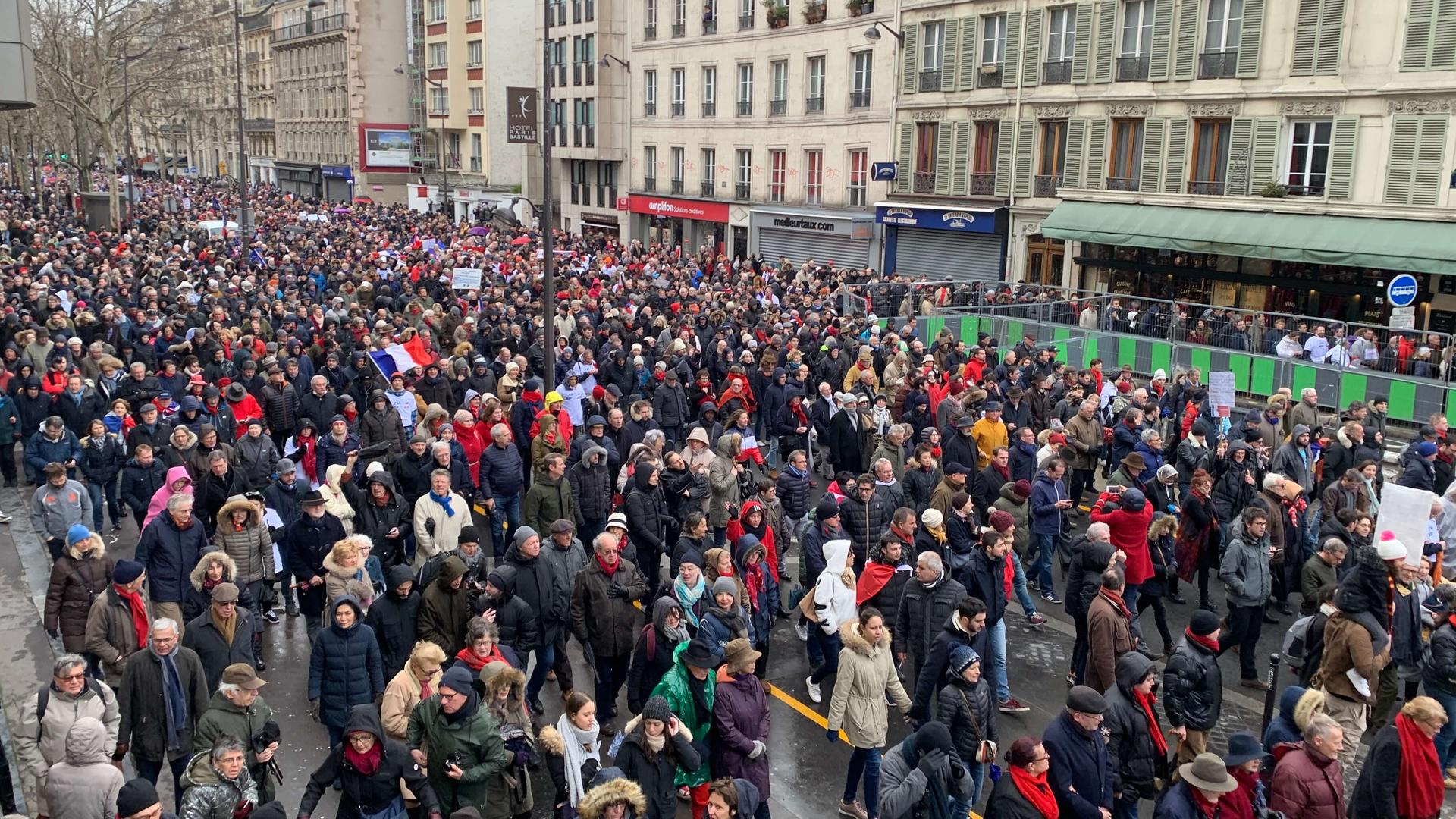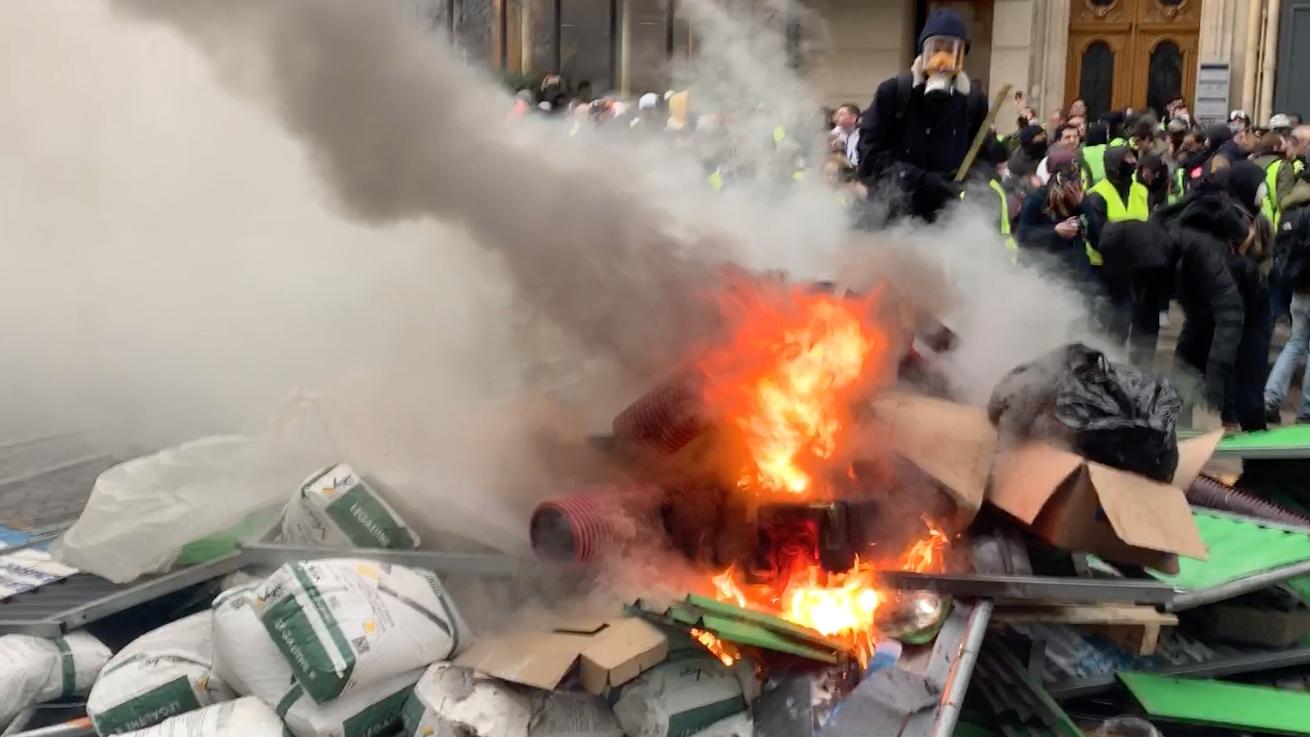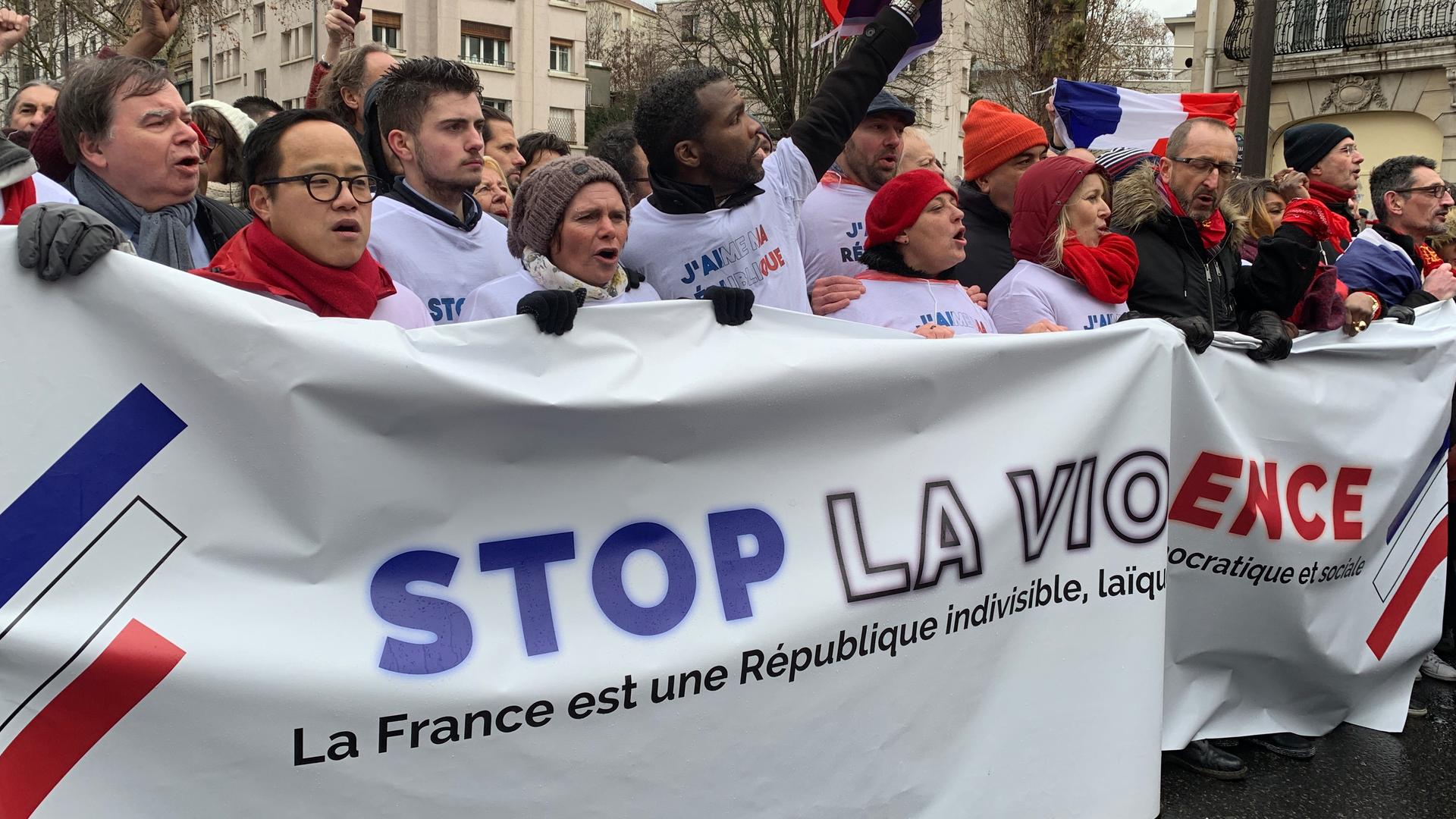Parisians don red scarves calling for end to yellow vest violence
Protesters marched in Paris on Jan. 27, 2019, as part of the “red scarves” movement against the violence that has arisen with the yellow vest movement, a series of anti-government demonstraions that began with a proposed fuel price hike.
After 11 straight Saturdays of anti-government protests that have swept across France, a group of thousands says they have had enough of the violence.
Donning red scarves to try to stand out as much as the fluorescent yellow vests, they marched through the streets of Paris on Jan. 27, holding a large banner that read, “Stop the violence.”
“I’m not against the yellow vest movement, but there are too many people getting hurt, too many rioters.”
“I’m not against the yellow vest movement, but there are too many people getting hurt, too many rioters,” said Claude du Granrut, 89, a member of the French Resistance during World War II.
Walking with her cane, and with an abundance of energy, du Granrut slowly weaved her way through the crowd amid tight security — organizers wanted to ensure their event was violence-free.
“I stand in solidarity with the government. I would like the protests to stop. We have the grand debates going on right now. They should participate in the debates instead and talk about what’s not working,” said du Granrut.

In January, Macron announced three months of national town hall meetings — “grand debates” — to hear the grievances of protesters in the hopes of appeasing them. In a letter to the French people published on Jan. 13, Macron explained the debates were a way to “transform anger into solutions.”
But some of the yellow vest protesters are skeptical of the meetings.
“We don’t believe in the grand debates. That is just to buy time,” said Jean-Baptiste Voluan, a yellow vest protester who marched down the famous Avenue des Champs Élysées on Saturday as he has done many times before.
The movement, which began in response to planned fuel tax hikes, has since ballooned into public anger over general living standards. It has brought people together from the far-left and the far-right, citizens who differ in their politics, but have found common ground in their core belief that it’s harder for them to get by.
People like 37-year-old Benjamin Bak, a part-time nursing aid from Épinay-sur-Seine, a suburb north of Paris, who has been at the demonstrations since the beginning.
“I make 579 euros [$662] a month after taxes. I’m on social assistance, but even with social aid, life is difficult.”
Bak says with his salary, he struggles to buy groceries.
“I eat pasta pretty much every day. Because it costs the least.”
“I make 579 euros [$662] a month after taxes. I’m on social assistance, but even with social aid, life is difficult. … I eat pasta pretty much every day. Because it costs the least.”
The middle class feels increasingly squeezed by high taxes. They’re also revolting against Macron’s fiscal policies that they believe favor the rich, including wealth tax cuts that the government says are aimed at attracting investors and revitalizing the eurozone’s second-largest economy.
Beginning in November, protesters donned their yellow vests (gilets jaunes) — mandatory in all vehicles in France — as they set up road blockades and marched in the streets. The grassroots movement that began through social media started in rural towns and suburbs before culminating into mass movements in the French capital.
The protests have sometimes turned violent. Across France, 10 people have died, mainly due to traffic accidents; thousands have been arrested, and a trail of destruction has been left behind with store windows smashed and banks on major streets boarded up in anticipation of the riots.
During Saturday’s protest in Paris, 52 people were arrested. Rioters started fires by Place de la Bastille, a central square, and police responded with tear gas and water cannons.

A prominent yellow vest organizer, Jerome Rodrigues, was seriously injured after a projectile struck his right eye, reportedly launched by police. Rodrigues later said on Facebook that he lost his eye.
France’s Interior Minister Christophe Castaner condemned the latest round of violence, and in a tweet, attributed it to “rioters who are camouflaged as yellow vest protesters.”
After several weeks of rallies, Macron made concessions. He canceled the planned fuel hike. And in an address to the nation on Dec. 11, the French president announced a $114 a month increase to the minimum wage and doing away with tax on overtime. But it hasn’t been enough to placate the fervor of yellow vest demonstrators who have continued their marches.
“If everyone attacks everyone else, society falls apart,” Macron added in his Jan. 13 letter. Macron also explained that cutting taxes would have to mean less welfare in a nation that spends more on welfare as a percentage of gross domestic product than any other country in the world.
But his letter also took on a political tone. Macron suggested discussing the introduction of immigration quotas for people coming from non-European Union countries, posing the question, “As regards immigration, once our asylum obligations have been fulfilled, would you like us to be able to set ourselves annual targets defined by Parliament?”
Cutting immigration has not been a central demand of the populist revolt, but many of the demonstrators are white, from suburbs and small towns. And political parties are seeing an opportunity to latch onto the movement.
The country’s far-left leader, Jean-Luc Mélenchon of the France Unbowed (LFI) party has sympathized with the movement, tweeting that the Jan. 2 arrest of Eric Drouet, one of the yellow vest organizers, was an “abuse of power.”
On the other side of the political spectrum, France’s far-right leader, Marine Le Pen of the anti-immigration National Rally (RN) party, has tried to appeal to yellow vest protesters while launching her party’s campaign for the May 26 European Parliament election.
At a Jan. 13 rally, Le Pen urged voters to make their choice based on Macron’s policies, saying, “In the context of the healthy popular revolt of the yellow vests, this European election on May 26, 2019 … offers the opportunity to unravel the political crisis born out of blindness, intransigence, class contempt, economic despoliation, and the human disconnect of a president.”
For the first time, Le Pen jumped ahead of Macron in October in an EU poll done by the polling firm Ifop. And in early December, Le Pen’s RN party captured 24 percent of voter support compared to Macron’s Republic on the Move’s (REM) 18 percent.
“I’ve had enough of the yellow vests protests. More than enough. I’m ashamed of my country. … That’s enough.”
But Macron’s popularity appears to be on the rise again after his New Year’s address in which he decried the violence of a “hateful mob” — in reference to extremist elements among the anti-government protesters that has led to anti-Semitic, racist and homophobic incidents. A Jan. 16 Ifop poll showed his party had overtaken Le Pen’s — with 23 percent of support compared to Le Pen’s 21 percent.
The populist wave now appears to be spreading beyond France’s borders, with people donning the high visibility vests in Belgium, the Netherlands, Portugal, the UK, Israel, Lebanon and Canada, voicing a range of grievances against the government.
At the end of Sunday’s anti-violence rally, a sea of red descended on the same Parisian square where violence broke out Saturday. They were met by a handful of yellow vest protesters, separated by barriers, with a heavy police presence keeping track of both sides. The countermovement remained relatively peaceful.
“I’ve had enough of the yellow vests protests. More than enough. I’m ashamed of my country,” said Brigitte, 68, a red scarf demonstrator who didn’t want to give her last name.
Brigitte admits she’s not necessarily a supporter of President Macron. “I didn’t vote for him. But all this [violence] makes me sick,” she said. “That’s enough.”
